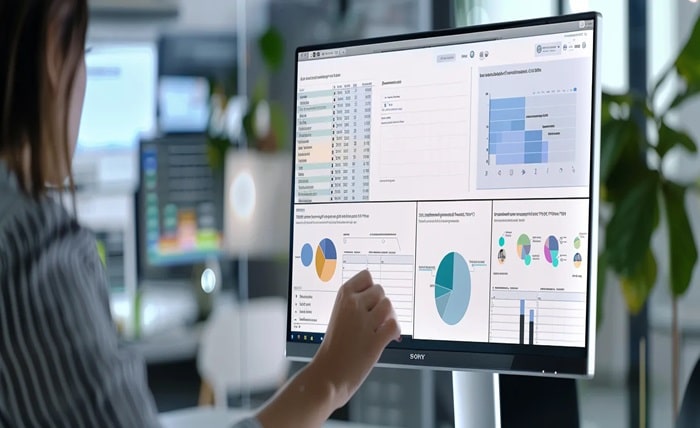Essential Features To Look for in Proposal Software

Proposals are the bread and butter of securing new business and maintaining a competitive edge. Choosing the right software to create and manage these documents is crucial, as it can streamline the entire proposal process, allowing businesses to present their offers with professionalism and efficiency. Customization, collaboration, integration, analytics, and user experience are key features that can make a significant difference in proposal management. Below, we explore the essential features you should seek in proposal software, ensuring that your business maximizes its potential to win contracts and grow.
Understanding the Importance of Customization Capabilities in Proposal Software
Alt text: A woman analyzes graphs on a computer, showcasing proposal software features for effective data presentation.
Customization is a key feature of effective proposal software, allowing businesses to tailor proposals to suit each client’s unique needs. From adjusting layouts to incorporating brand elements, customizable templates save time and ensure consistency while delivering a professional touch. This personal approach can significantly influence client decisions.
The best proposal software features should offer robust yet user-friendly customization tools. Businesses need systems that are easy to navigate, enabling teams to craft proposals efficiently without requiring extensive training. This ensures a seamless process and increases the chances of success.
Evaluating the Collaborative Features for Team Efficiency
In today’s remote work environment, collaborative features in proposal software are crucial for enhancing the quality and speed of the proposal creation process. These features include version control, commenting, task assignment, and notifications, which ensure everyone is working on the latest version of the document. These tools also keep team members informed about any updates or changes, preventing any details from being overlooked.
Collaborative features also reduce errors and inconsistencies, as multiple eyes can catch typos, inaccuracies, or formatting issues early, enhancing the professionalism of the final proposal. Software should have administrative functions that allow team leaders to manage access and permissions, ensuring sensitive information is protected and shared only with the relevant people, thereby maintaining confidentiality and integrity throughout the proposal process.
Assessing Integration Options for Seamless Workflow
When choosing proposal software, it’s crucial to consider its integration capabilities. The software should seamlessly connect with other business systems like CRM or project management tools, improving workflow efficiency and reducing errors. It should also integrate with existing tools, simplifying tasks like importing contact details or scheduling.
Strong integration also allows for better tracking of the proposal’s impact, allowing for correlation with sales outcomes. It’s essential to ensure the integrations are reliable and don’t require extensive custom coding, as this can introduce complexity and potential failure points. The software provider should offer support and updates to maintain these integrations over time.
The Role of Analytics and Reporting Tools in Proposal Management

Alt text: A man working at a desk with a computer and phone, concentrating on analytics and reporting activities.
Proposal management relies heavily on analytics and reporting capabilities to identify successful and unsuccessful proposals. Proposal software should track key metrics like win rates, average time spent, and client engagement. Robust yet easy-to-interpret dashboards can provide valuable insights, helping identify trends and patterns.
This informs strategic decisions, such as which template designs are most engaging or which pricing strategies yield the best results. Deep-dive analysis of detailed metrics allows for fine-tuning of the proposal process, enabling sales teams to focus on their most effective areas. Advanced software systems can also track client interaction, enabling sales teams to refine their focus areas.
Prioritizing User-Friendly Design and Support in Proposal Software Selection
The user experience is crucial for productivity in proposal software. A user-friendly interface should guide presenters through the proposal creation process without constant reference to manuals or help guides. A user-friendly software should offer quick access to common tasks, intuitive navigation, and a pleasant visual design, reducing the learning curve for new users and increasing adoption rates. A simpler tool increases the likelihood of team members fully utilizing its capabilities.
Customer support and training resources also play a significant role in the long-term usability of the software. A responsive support team can resolve any issues, preventing delays in the proposal process. Regular updates and improvements to the software ensure its relevance and value to users over time.
Overall, a well-rounded proposal software is an investment that pays dividends by streamlining the proposal process, improving collaboration, and offering valuable insights. By carefully considering customization, collaboration, integration, analytics, and user experience, businesses can select a software solution that not only facilitates the creation of persuasive proposals but also contributes to a strategic advantage in the marketplace. With the right tool in hand, the proposal workflow can become a powerful engine for growth and success.





